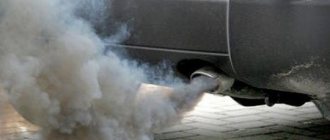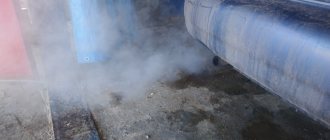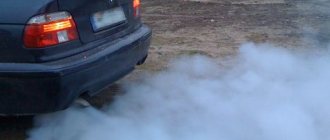How to detect soot in the muffler
It’s worth making a retreat right away; a small amount of soot in the muffler is acceptable. It can form over time. This soot is more like dust, and its layer can be easily removed, usually with a rag in one pass. However, if you see a build-up in the form of a black ring at the end of the pipe or a layer of soot in its inner part is more than 1 mm, there is most likely a malfunction in the engine.
This defect can be detected by simple visual inspection. For greater clarity, you can carefully run a wooden stick along the inner ring of the pipe. If soot covers the entire pipe, then it’s worth visiting a specialized service station to diagnose or repair the motor.
Often this phenomenon is discovered after refueling at unfamiliar gas stations. This does not greatly affect the driving performance of the car. There are no changes in dynamics or power. But soot appears in the pipe, and this is a bad sign.
How is black smoke formed?
In most cases, black plume emissions are a consequence of incomplete combustion of the fuel mixture inside the cylinders. The black tint is caused by volatile particles coated with soot that travel through the exhaust pipes along with exhaust emissions. At the same time, the entire system becomes contaminated and the power plant malfunctions.
For most diesel cars, the presence of a small amount of black smoke at the start is not always a cause for concern for the car owner. In the case of gasoline engines, you must first of all avoid visiting gas stations with low-quality fuel and undergo diagnostics.
Why does soot occur?
The main reason is incomplete combustion of fuel in the engine. More precisely, the engine runs on a richer fuel mixture, as a result of which its complete combustion does not occur. Some of the gasoline burns outside the engine and the soot is not removed naturally, but remains in the exhaust system.
A rich mixture can form for several reasons:
- Due to poor quality fuel. Dilute gasoline does not have the desired detonation. For full operation of the engine, more fuel is required. Sensors that support the desired power parameters believe that the mixture needs to be enriched. The result is a larger volume of fuel, some of which is exhausted.
- Due to a malfunction of one or more sensors. Most often, a breakdown occurs in the lambda probe, which is responsible for supplying fuel to the engine.
- Due to incorrect or incorrect operation of the spark plugs. In this case, the fuel simply does not burn out from a bad spark.
- Due to a dirty air filter. The engine chokes, it requires more power, and more fuel enters the system.
However, the presence of black soot in the pipe does not always indicate a serious malfunction in the engine. Most often, such things can be fixed without repairing the internal combustion engine.
Blue smoke from the exhaust pipe
Blue smoke from the exhaust pipe indicates serious problems with the engine. There may be several reasons, including damage to the cylinder head, as well as the cylinder-piston group through which oil enters the combustion chambers. Oil leaks into the combustion chambers when the valve stem seals wear out, as well as due to the appearance of scuffs on the cylinder walls and due to a number of other malfunctions.
The car owner needs to contact a service center as soon as possible and have the power unit inspected.
Black smoke in modern engines with injection and turbines also appears when the combustible mixture is too rich. A malfunction, as a rule, indicates a failure of one of the sensors.
If the engine is equipped with a turbocharger, and blue smoke appears after it warms up, this is due to a malfunction of the turbine.
If blue smoke is noticed when buying a car on the secondary market, then it is better to refuse to buy the car.
Question answer
Is it necessary to warm up a car in the summer heat?
Is the presence of black plaque always a sign of malfunction?
Black plaque is not always a wake-up call. Sometimes soot occurs due to an incorrectly tuned engine. For example, when the distributor in the car is set incorrectly, for later ignition. This drawback can be eliminated yourself by placing the distributor in a different position.
In some cases, you can simply try cleaning or replacing the spark plugs and changing the air filter.
Sometimes soot formation can occur when the car is parked for a long time and. In this case, the engine also runs on a richer mixture, which leads to the formation of a small amount of soot and is not a malfunction.
White smoke from the chimney with a characteristic chemical odor
The appearance of a large amount of white smoke from the exhaust pipe indicates a loss of tightness of the cooling system. Antifreeze can leak into the combustion chambers through a damaged cylinder block gasket. It also enters the engine crankcase and mixes with oil. When burned, antifreeze turns into white smoke.
In such a case, the driver sees thick white steam from the pipe, which does not pass as the engine warms up.
In this case, the car owner will face complex and expensive repairs. Most often you will have to replace the cylinder head, and this is one of the most expensive engine parts.
How to check: is the appearance of soot caused by a malfunction or is this a normal condition?
The first thing to do is change the refueling location. You can also try using higher octane gasoline if your engine can handle it.
Most often, the reason lies precisely in low-quality fuel. In addition, you need to look at the condition of the spark plugs and air filter. If necessary, replace them too.
If these preventive actions do not produce results, it is worth stopping by a service station and checking the distributor and sensors responsible for fuel combustion in the engine.
Black soot on the exhaust pipe
If a large amount of black soot appears on the edges of the exhaust pipe, you should be wary. As a rule, black deposits indicate problems with the fuel system. An over-enriched mixture enters the engine, and, as a result, gasoline consumption increases. If the car has a carburetor, then you can adjust the mixture yourself with a simple screwdriver. If there is an injector, you will have to check the control unit.
Most often, the presence of soot on the exhaust pipe is a death sentence for particulate filters and the catalyst, which can become clogged and not do their job.
How can you determine the condition of the engine by looking at the exhaust pipe and the color of the exhaust?
Experienced motorists with extensive experience always closely monitor the exhaust pipe of their car - and for good reason. Sometimes condensation pours out of there, at other times soot particles fly out or a black coating appears on the edges of the pipe. This is a consequence of the processes occurring in the motor. Using these traces, you can determine the quality of the fuel poured, the condition of the catalyst, wear of the piston rings, and even the condition of the engine cooling system gaskets. All this will be useful for cars that have long expired their warranty period and can at any time upset the owners with expensive repairs. The sooner the driver diagnoses the problem, the less hassle he will have in the future.
Why does the muffler exhaust pipe turn black?
There are only two main reasons for a black exhaust pipe of a car muffler: it is thrown into the muffler and burns out there, creating black carbon deposits - either unburned fuel (fuel mixture is too rich) or motor oil. A combination, in varying proportions, of these two reasons often occurs.
Now in more detail about the reasons for the black muffler pipe associated with over-enrichment of the fuel mixture
The carburetor or fuel system of the car engine is faulty
— The fuel and/or air jets of the carburetor are clogged or do not correspond to the rating
— Engine air filter clogged
— Fuel level in the carburetor float chamber is too high
— The shut-off needle valve in the carburetor float chamber has lost its tightness
— Engine idle speed is incorrectly adjusted
Fuel pump is faulty
— The protrusion of the pusher is too large, resulting in the fuel pump “pumping” (creating excess pressure in the system at the inlet to the carburetor)
Also, the reasons for the receipt of a rich fuel mixture may be a malfunction of the ignition system.
— Ignition too early
— The gap between the breaker contacts is too small (for a contact ignition system)
— Elements of the ignition system are faulty: spark plugs, armored wires, coil, distributor with vacuum and centrifugal ignition timing sensors, distributor cover, “slider”, etc.
— A “breakdown” of ground elements in the ignition system leads to disruption of spark formation and, accordingly, incomplete combustion of the fuel mixture.
Or a malfunction of the engine itself
— Worn piston group
— The valve clearances do not meet the standard
— The valve timing is off (the timing chain or belt is not aligned)
Reasons for oil getting into the muffler
— The piston rings (or the CPG as a whole) are worn out or stuck
Engine oil is not removed from the cylinder walls and, without burning in the mixing chambers, it is thrown out and burns out in the exhaust system, creating black soot. In this case, the spark plugs will be in oil.
— Worn oil seals
A situation similar to that described above occurs.
— The engine crankcase ventilation system is clogged
See “Cleaning the crankcase ventilation system of VAZ 2108, 2109, 21099 cars.”
After using the car for some time, with at least one of the listed faults, we get a black exhaust pipe from the muffler. In the exhaust system of a serviceable engine with working systems, the exhaust pipe is clean or with minimal black deposits, which is not a malfunction for a used carburetor engine.
Notes and additions
— Associated signs of a black exhaust pipe are: “shots” or pops in the muffler, black or blue (gray) smoke from the muffler, “triple” of the engine, difficulty starting it, increased fuel and oil appetite, spark plugs with black or/and oil deposits on the electrodes, engine oil leaks under the seals and getting into the air filter, etc.
— In some cases, too small an ignition timing angle (late ignition) leads to an over-enrichment of the fuel mixture and blackening of the muffler exhaust pipe.
More articles on malfunctions of the carburetor engine of VAZ cars
— The idle speed of the carburetor engine cannot be adjusted
— Glow ignition (signs, causes)
— Signs and causes of failure of a carburetor engine
To preserve engine life...
Be that as it may, you should clearly know that black exhaust is dangerous not because it spoils the environment (soot flies out of the muffler and smells of gasoline), but also disrupts the normal operation of the engine, leads to increased fuel consumption and reduces the efficiency of its operation. You should always remember that particles of coked fuel not only fly out of the muffler, but also enter the piston group, becoming an abrasive and rapidly wearing out the polished (ideally, like a mirror) working surface of the liners, pistons and sealing rings.
This can lead to a noticeable drop in the service life of the engine, and instead of the required, say, according to the passport data, 500 thousand kilometers (modern cars are designed for approximately this service life) before repair, the engine will work an order of magnitude less. This is why black exhaust from an engine muffler is dangerous in the first place. » alt=»»>
Let's sum it up
So, to eliminate black, white, and blue smoke, sometimes it is enough to replace the filter and clean the injectors. Whereas in more serious cases it is necessary to repair the engine and its mechanisms.
It must be remembered that if the engine suddenly starts smoking black, you need to replace the fuel, since low-quality fuel, with a high content of additives and undesirable impurities, leads to a change in the color of the exhaust and difficulties in combustion of the mixture.
Do not forget that the timing belt must be installed according to the marks, the valves and valve timing must be clearly adjusted, the thermal clearance of the valves must be correctly installed. Spark plugs, during diagnostics, will help assess the condition of the engine.
The stability, reliability and durability of the power unit directly depends on everything, and many other indicators.











